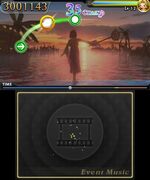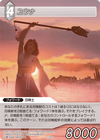
Yuna performing the sending.
The dead need guidance. Filled with grief over their own death, they refuse to face their fate. They yearn to live on, and resent those still alive. You see, they envy the living. And in time, that envy turns to anger, even hate. Should these souls remain in Spira, they become fiends that prey on the living. Sad, isn't it? The sending takes them to the Farplane, where they may rest in peace.
The Sending (異界送り, Ikai Okuri?, lit. Spirit World Sending) is a ceremony summoners perform in Final Fantasy X that helps guide the spirits of the dead to the Farplane. Sending is performed via dance ritual. Sending the dead is not mentioned in Final Fantasy X-2, but Final Fantasy X -Will-, an audio drama written by Kazushige Nojima, reveals that sendings are still being performed, now by dedicated people known as senders.
Later it evolved into Yuna's Limit Break-type ability simply called The Sending, first appearing in Dissidia 012 Final Fantasy due to her requiring a damage-dealing EX Burst since her original Overdrive from Final Fantasy X was a support-oriented ability.
Nature[]

Yuna performs the sending in Kilika.
Sending dispatches perished sentient lifeforms' spirits to the Farplane, a place that exists on the inside of the planet of Spira and is the planet's life energy. The lifeform's sentience is crucial, as pyreflies from plants and fiends do not need a sending.
Unsent spirits eventually become fiends. When someone dies without accepting death, the pyreflies that made up their "soul" may be trapped in the world of living. If the person has a strong enough conviction to remain in the world of the living, their pyreflies may take the form of the deceased's former body and remain in Spira as an unsent. The spirits remaining in the world may begin envying the living, the envy turning to hate and resentment and turning them into fiends.
In rare cases, a sent spirit can leave the Farplane if they still have a strong attachment to the world of the living. The only known occurrence of this is when Jyscal Guado leaves the Farplane to give Yuna a sphere of Seymour. Despite being an unsent, Auron does not disappear when Yuna is sending Jyscal Guado, although he is in pain. This implies the sending's full effects only apply when the summoner is focused on sending a certain group.
A spirit doesn't necessarily need to be sent to find its way to the Farplane; in fact, as there are only a limited amount of summoners, and their main job isn't performing the sending, but, rather, completing the pilgrimage, it is likely most people do not need a sending. Sending is required most commonly when a person dies in violent or otherwise unusual circumstances, as their spirit still has "unfinished business" back in the world of the living. Once an individual has accepted death they will return to the Farplane without the need of sending. Even the individuals who go on to become unsent possess this ability.
Story[]
Final Fantasy X[]
I wished there would never be a next time. No more people being killed by Sin. No more sendings for Yuna. Everyone stood there watching her. It was strange, and somehow... horrifying. I never wanted to see it again.
Tidus, ruminating on the sending
Sending is likely an ancient ritual used in the ancient Zanarkand as the metropolis was known to use summoners. During the present day Spira summoners perform the sending, but this is not their main purpose. Summoner Yuna performs the sending on numerous occasions during her pilgrimage. The first time is after Sin destroys Kilika. The bodies are laid in the water in floating coffins and Yuna performs the sending while walking on the water. As she dances the water surges to form a column as the pyreflies are released from the bodies. Later, Yuna performs the sending for those who died in Operation Mi'ihen.
After Seymour Guado is killed Yuna tries to send him, but is interrupted and the Guado take Seymour's body away and he becomes an unsent. When escaping from the Macalania Temple where they had killed Seymour, Yuna's party runs into Sin and is taken to Bikanel. In the commotion, Yuna is separated from the others. Guado attack the Al Bhed settlement in Bikanel where Yuna's guardians find the missing summoners whom the Al Bhed have held captive to stop their pilgrimage. The freed summoners perform the sending over those who died in the Siege of Home before escaping on the Fahrenheit.

Yuna sends the aeons.
Yuna was taken to Bevelle to wed the unsent Seymour. She goes along with the plan in the hopes of getting a chance to send him, but is unable to do so when her friends are held hostage. When the party finally defeats the unsent Seymour inside Sin, he lets Yuna send him, glad it was Yuna who would perform the deed. At the end of their journey the party defeats Braska's Final Aeon at Dream's End and Yuna sends her aeons and Auron, who enter the Farplane. This is the last time Yuna is known to perform the sending.
Final Fantasy X-2[]
After the Eternal Calm begins some view summoners obsolete, with Beclem deriding Yuna as a relic of the past. The tradition of performing sendings seems to have ended; Final Fantasy X-2 Ultimania Omega elaborates that pyreflies continued to appear in great numbers as Sin's destruction broke the cycle of sending the dead to the Farplane, resulting in the sudden increase of fiends, as pyreflies are their lifeforce.[1]
Final Fantasy X-2.5 ~Eien no Daishō~[]
Yuna's ability to perform the sending is still being recognized, as an ancient Jūshin asks her to not send her beckoned form to the Farplane. Yuna complies, and the ancient spirits fade away on their own.
Final Fantasy X -Will-[]
Sendings are still being performed, now by people known as senders. When the ghostly dead are being beckoned back to Spira, Kurgum, a sender, wants to send the illusions back to the Farplane, but Yuna stops him, saying they don't have the right to interfere.
Musical themes[]
The music that accompanies the sending is a solemn rendition of the "Hymn of the Fayth". It mirrors Japanese ceremonial music, complete with Japanese instruments. Aptly titled "The Sending" (異界送り, Ikai Okuri?), it is the third track in the second disc of the Original Soundtrack and is composed by Masashi Hamauzu.
Other appearances[]
Theatrhythm Final Fantasy[]

Yuna performing the sending.
Scenes from the sending in Kilika appear in Event Music Sequence for Final Fantasy X series.
Final Fantasy Trading Card Game[]
A trading card depicting Yuna performing the sending appear on a card.
Behind the scenes[]
Many cultures and religions have funeral rites with belief that failure to perform them will lead for the spirit to be unable to find rest. The dancing element of the sending in Final Fantasy X may refer refer to Shintoism, as Kagura (神楽, かぐら, god-entertainment?) is the ancient Shinto ritual dance of shamanic origin, with the legend stating that the sun goddess Amaterasu became upset at her brother and hid in a cave. Ame-no-uzume began to dance and create a commotion to entice Amaterasu to come out. The kami (gods) tricked Amaterasu by telling her there was a better sun goddess in the heavens and Amaterasu came out and light returned to the universe.
In both ancient Japanese collections, the Nihongi and Kojiki, Ame-no-uzume's dance is described as asobi, which in old Japanese language means a ceremony designed to appease the spirits of the departed, conducted at funeral ceremonies. Therefore, kagura is a rite of tama shizume, of pacifying the spirits of the departed. Spirits were pacified and rejuvenated in ancient Japan by songs and dances, also called asobi.
Danse Macabre, French for "dance of death", is an artistic genre of late-medieval allegory on the universality of death: no matter one's station in life, the dance of death unites all, similar to the ritual of the sending.
Yuna's original attire was changed from a dress ![]() to the furisode seen in-game, because Tetsuya Nomura wanted an outfit that would "flow" when she performs the sending.[citation needed]
to the furisode seen in-game, because Tetsuya Nomura wanted an outfit that would "flow" when she performs the sending.[citation needed]
Gallery[]
References[]
- ↑ Final Fantasy X-2 Ultimania Omega p.085











